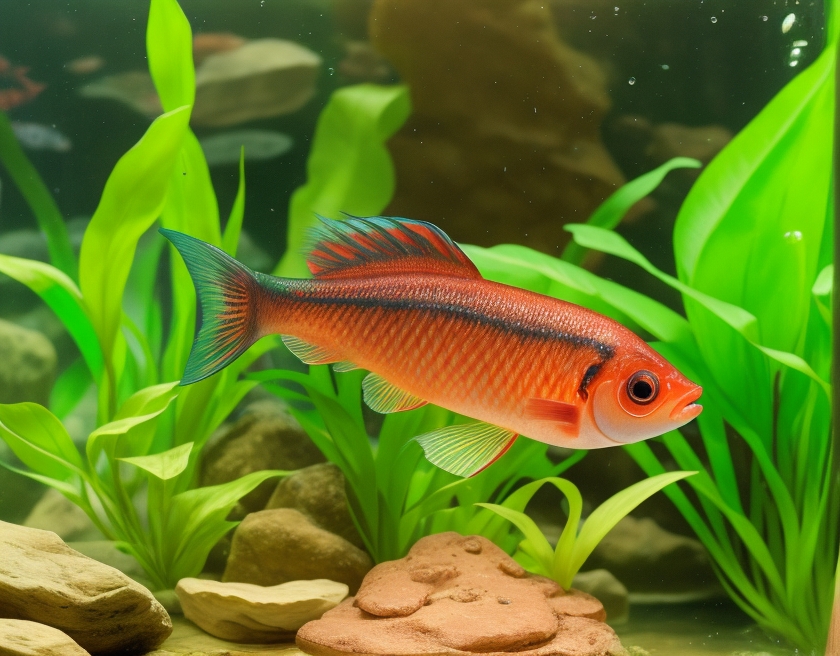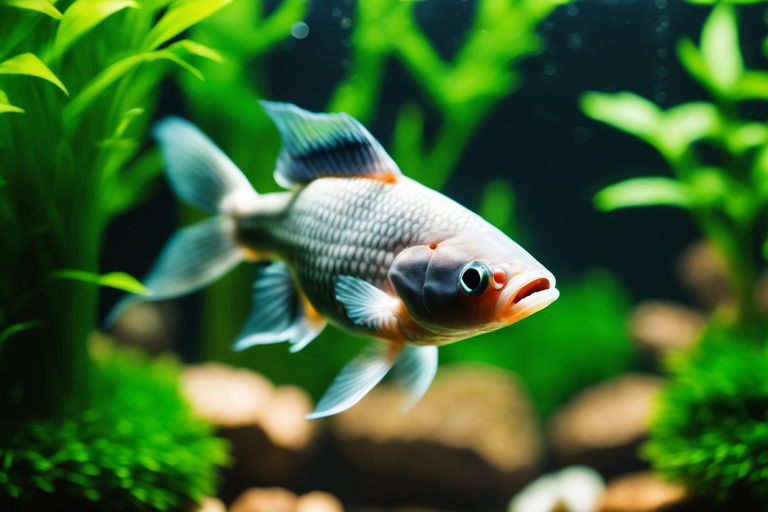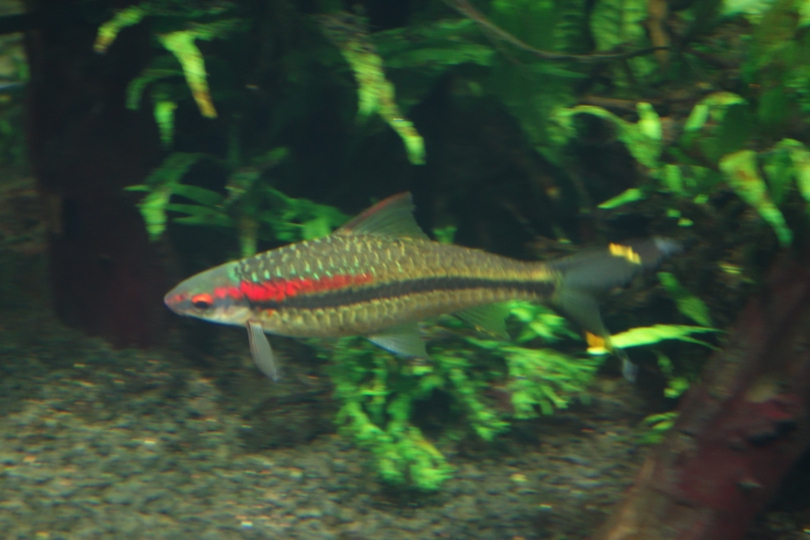Are you thinking about getting a Denison Barb for your aquarium? These active and colorful fish are a great addition to any tank!
In this complete care guide, you’ll learn all about their appearance, behavior, tank requirements, tank mates, diet, and breeding.
Get ready to learn all you need to know to give your Denison Barb the best care!
Here are some quick facts about the Denison Barb:
- Species: The Denison Barb (Sahyadria denisonii), also known as Denison’s Barb, Miss Kerala, Red-line Torpedo Barb, or Roseline Shark, is an endangered species of cyprinid fish endemic to the fast-flowing hill streams and rivers of the Western Ghats in India2.
- Appearance: Denison Barbs have long, torpedo-shaped bodies in silver with black lines that extend the length of their bodies. They also have a bright red line that runs horizontally along their sides, giving them a striking and attractive appearance6.
- Size: Denison Barbs can grow up to 6 inches (15.24 cm) in size5.
- Habitat: In the wild, Denison Barbs are found in the fast-flowing Achankovil, Pamba, and Chaliyar rivers in India3. They are known to occur in rocky pools with thick vegetation along their banks2.
- Tank Size: A minimum tank size of 55 gallons is recommended for a small group of Denison Barbs4. They require ample swimming space due to their active nature.
- Tank Mates: Denison Barbs are generally peaceful, but some individuals have been known to be slightly aggressive around food, especially if kept in less space than they require2. They can be kept with other peaceful fish of similar size and temperament.
- Diet: In the aquarium, Denison Barbs are omnivorous and will eat a variety of foods. Their diet should include bloodworms, shrimp, meat, fish flakes, and some vegetation2.
- Breeding: Breeding Denison Barbs can be challenging, and they are not commonly bred in captivity. They require specific water conditions and a well-established tank to breed successfully6.
Overview and Quick facts
You’ll find caring for a Denison Barb easy with this complete care guide.
The Denison Barb is a freshwater fish that’s native to India, Pakistan, and Myanmar. It’s a peaceful fish that can reach about 4 inches in length, and its body is slender and streamlined.
This species of fish has an omnivorous diet, meaning it will eat both plant-based and animal-based foods, but it prefers insect larvae and crustaceans in the wild. In captivity, it will accept most commercially available fish foods.
When it comes to tank maintenance, Denison Barbs like to have plenty of swimming space and lots of hiding places. The tank should be at least 20 gallons and contain plenty of vegetation and rocks. To keep the water clean, regular partial water changes are essential.
Appearance & Behavior
You can easily recognize the Denison Barb by its slender, streamlined body. It has a silver to golden-yellow body with a black stripe running along its length and a red-orange tail. Denison Barbs are usually around 3-4 inches in length. When it comes to caring for these fish, it’s important to keep their fins healthy. Regularly check for any signs of fin damage or disease and treat them right away.
The Denison Barb is an active and sociable species, often seen in groups of four or more. They can be kept with other peaceful fish of similar size and temperament. It can be hard to distinguish males from females, but males tend to be a bit slimmer and have more pointed caudal and dorsal fins. Females tend to have rounder caudal and dorsal fins.
Denison Barbs are omnivorous and will eat a variety of live, frozen, and flake foods. They should be given a high-quality diet with a variety of proteins, vitamins, and minerals. Provide them with plenty of hiding spots, like driftwood and live plants, to keep them comfortable and stress-free.

Care and tank requirements
Regularly and carefully monitor the tank requirements for your Denison Barbs to ensure their health and well-being. Keeping your Denison Barbs in an aquarium with the right size and temperature is crucial for them to live a long and healthy life.
The ideal tank size for a Denison Barb is between 30-45 gallons, and the temperature should remain between 22-24°C (71-75°F). Having the right size tank allows the Denison Barbs to get enough exercise and to explore their environment. The temperature shouldn’t vary too much, as Denison Barbs can become stressed in fluctuating water temperatures.
The aquarium should also have plenty of hiding spots, rocks, and plants for them to hide from one another and rest. Denison Barbs are relatively peaceful fish but can become aggressive when they’re kept in a small space. To ensure their health and well-being, it’s advised to keep them in a larger tank with plenty of room to swim.
In addition to the tank size and temperature, the water quality is also very important. Regularly check the pH, nitrite, and nitrate levels of the tank. These levels should remain consistent to avoid any fish stress or health concerns. You can also add a water conditioner to the tank to help keep the water clean and free from dangerous toxins.

Tank Mates
Choosing the right tank mates for your Denison Barbs is essential for a peaceful and healthy environment. When selecting tank mates for your Denison Barbs, there are a few important things to consider:
Denison Barb, also known as the Red Line Torpedo Barb, is a semi-aggressive fish species that belongs to the family Cyprinidae. They are native to streams and rivers in Southeast Asia. When it comes to choosing tank mates for Denison Barbs, it’s crucial to consider their temperament and potential compatibility with other fish species.
Here are some suitable tank mates for Denison Barbs:
- Peaceful Community Fish: Tetras (such as Neon Tetras or Emperor Tetras), Rasboras (like Harlequin Rasboras) or smaller peaceful catfish like Corydoras spp., make excellent tank mates with Denison Barbs due to their similar size and peaceful nature.
- Rainbowfish: Species like Boesemani Rainbowfish or Threadfin Rainbowfish can coexist well with Denison Barbs in a spacious aquarium setup.
- Other Semi-Aggressive Cichlids: If you want a more diverse community setup, larger cichlid species such as Angelfish or Gouramis can be added but careful observation should be practiced initially after introducing them into the same tank.
- Bottom Dwellers: Bristlenose Plecos, rubber lip plecos or other similarly-sized bottom-dwelling catfish can be considered given they have caves/hiding places at the bottom of the aquarium where they won’t encounter aggressive behavior from fast-swimming Denison barb
Diet and Feeding
For a healthy and balanced diet, you’ll need to feed your Denison Barbs a variety of foods and regularly provide supplements. Feed your Denison Barbs several times a day in small portions. A good variety of food includes live, frozen, and freeze-dried foods like blood worms, brine shrimp, daphnia, and mosquito larvae. You can also feed them high-quality flakes, pellets, and other prepared foods. They’ll also appreciate the occasional treat of boiled vegetables, blanched spinach, or other plant material.
Maintaining a regular feeding schedule is important to ensure your Denison Barbs get the nutrition they need.
In addition to a varied diet, you should also supplement your Denison Barb’s diet with a vitamin and mineral supplement. This will help maintain their health and wellbeing. It’s also important to make sure you aren’t overfeeding them, as they can become obese and develop health problems.
With the right diet and feeding schedule, your Denison Barbs will remain healthy and active.
Now that we’ve discussed the importance of diet and feeding for Denison Barbs, let’s move on to the next section about breeding.
Breeding
If you’re looking to breed Denison Barbs, you’ll need to take some extra steps to ensure success. Here are a few steps you should consider:
- Get a ratio of two females to one male in your aquarium. This will help reduce aggression and make it easier for the male to mate with the females.
- Provide ample hiding places for the female fish. This will help reduce the stress caused by the male’s mating rituals.
- Monitor the water temperature carefully. The optimal range is between 74 and 82 degrees Fahrenheit.
- Make sure the water is well oxygenated. This will help facilitate successful breeding.
- Utilize breeding strategies such as the use of clay pots to provide a safe area for the female fish to lay her eggs.
Conclusion
You now have a good understanding of the Denison Barb and its care requirements. These fish are active and hardy, making them suitable for beginner aquarists.
When setting up the tank, make sure to provide plenty of space for swimming and hiding spots. With the right tank mates, diet, and care, you can create a healthy and thriving environment for your Denison Barbs.
With a bit of knowledge and effort, you can watch your colorful fish thrive in your aquarium.

